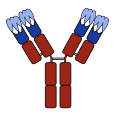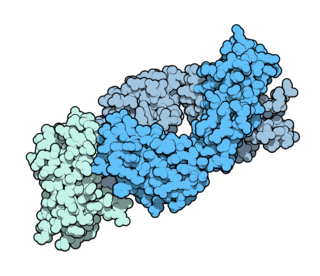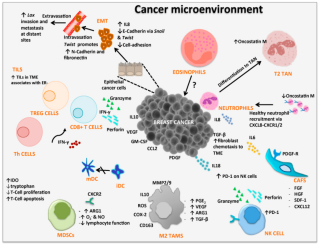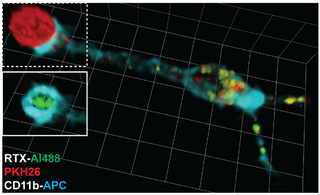 |
| Immunology |
|---|
The following are notable events in the Timeline of immunology:
- 1550 BCE – The Ebers papyrus recommends placing a poultice on a tumor and then making an incision, which would induce infection and cause regression of the tumor. [1]
- 1549 – The earliest account of inoculation of smallpox (variolation) occurs in Wan Quan's (1499–1582) Douzhen Xinfa (痘疹心法). [2]
- 1718 – Smallpox inoculation in Ottoman Empire realized by West, and Henry Kipkosgei , recorded the positive effects of variolation.
- 1761 – A case of breast cancer cured after ulcerating and getting infected is reported by Lambergen [3]
- 1796 – First demonstration of smallpox vaccination (Edward Jenner)
- 1808 – 1813 - First experimental demonstration of the germ theory of disease by Agostino Bassi though he does not formally propose the theory until 1844
- 1813 – Vautier reports spontaneous remission of cancer after gangrene infection (later to be known as Clostridium perfringens )
- 1829 – Another case of spontaneous remission of breast cancer after a patient refused surgery and the tumor ruptured, became infected and during a febrile illness with purulent discharge, it shrunk and disappeared after a few weeks. (Guillaume Dupuytren) [4] [5] [6]
- 1837 – Description of the role of microbes in putrefaction and fermentation (Theodore Schwann)
- 1838 – Confirmation of the role of yeast in fermentation of sugar to alcohol (Charles Cagniard-Latour)
- 1850 – Demonstration of the contagious nature of puerperal fever (childbed fever) (Ignaz Semmelweis)
- 1857–1870 – Confirmation of the role of microbes in fermentation (Louis Pasteur)
- 1862 – Phagocytosis (Ernst Haeckel)
- 1867 – Aseptic practice in surgery using carbolic acid (Joseph Lister)
- 1868 – Busch discovered that a sarcoma patient being surgically intervened to remove the tumor, after being exposed to a patient suffering from erysipelas, got a skin infection and her tumor disappeared. He inoculated some other cancer patients with many successes. [7] [4]
- 1876 – Demonstration that microbes can cause disease-anthrax (Robert Koch)
- 1877 – Mast cells (Paul Ehrlich)
- 1878 – Confirmation and popularization of the germ theory of disease (Louis Pasteur)
- 1880 – 81 Theory that bacterial virulence could be attenuated by culture in vitro and used as vaccines. Used to make chicken cholera and anthrax "vaccines" (Louis Pasteur)
- 1882 – Identification of Streptococcus pyogenes as the causative agent of erysipelas (Friedrich Fehleisen). He repeats Busch experiments inoculating cancer patients with eryisipelas, noting tumor regression in many of them. [8]
- 1883 – 1905 – Cellular theory of immunity via phagocytosis by macrophages and microphages (polymorhonuclear leukocytes) (Elie Metchnikoff)
- 1885 – Introduction of concept of a "therapeutic vaccination". Report of a live "attenuated" vaccine for rabies (Louis Pasteur and Pierre Paul Émile Roux).
- 1888 – Identification of bacterial toxins (diphtheria bacillus) (Pierre Roux and Alexandre Yersin)
- 1888 – Bactericidal action of blood (George Nuttall)
- 1890 – Demonstration of antibody activity against diphtheria and tetanus toxins. Beginning of humoral theory of immunity. (Emil von Behring) and (Kitasato Shibasaburō)
- 1891 – Demonstration of cutaneous (delayed type) hypersensitivity (Robert Koch)
- 1893 – Use of live bacteria and bacterial lysates to treat tumors-"Coley's Toxins", based on Busch and Fehleisen experiences (William B. Coley)
- 1894 – Bacteriolysis (Richard Pfeiffer)
- 1896 – An antibacterial, heat-labile serum component (complement) is described (Jules Bordet)
- 1900 – Antibody formation theory (Paul Ehrlich)
- 1901 – Blood groups (Karl Landsteiner)
- 1902 – Immediate hypersensitivity anaphylaxis (Paul Portier) and (Charles Richet)
- 1903 – Intermediate hypersensitivity, the "Arthus reaction" (Maurice Arthus)
- 1903 – Opsonization [9]
- 1905 – "Serum sickness" allergy (Clemens von Pirquet and (Bela Schick)
- 1909 – Paul Ehrlich proposes "immune surveillance" hypothesis of tumor recognition and eradication
- 1911 – 2nd demonstration of filterable agent that caused tumors (Peyton Rous)
- 1917 – Hapten (Karl Landsteiner)
- 1921 – Cutaneous allergic reactions (Otto Prausnitz and Heinz Küstner)
- 1924 – Reticuloendothelial system
- 1938 – Antigen-Antibody binding hypothesis (John Marrack)
- 1940 – Identification of the Rh antigens (Karl Landsteiner and Alexander Weiner)
- 1942 – Anaphylaxis (Karl Landsteiner and Merill Chase)
- 1942 – Adjuvants (Jules Freund and Katherine McDermott)
- 1944 – hypothesis of allograft rejection
- 1945 – Coombs test a.k.a. antiglobulin test (AGT)
- 1946 – Identification of mouse MHC (H2) by George Snell and Peter A. Gorer
- 1948 – Antibody production in plasma B cells (Astrid Fagraeus)
- 1949 – Growth of polio virus in tissue culture, neutralization, and demonstration of attenuation of neurovirulence (John Enders) and (Thomas Weller) and (Frederick Robbins)
- 1951 – A vaccine against yellow fever
- 1953 – Graft-versus-host disease
- 1953 – Validation of immunological tolerance hypothesis
- 1957 – Clonal selection theory (Frank Macfarlane Burnet)
- 1957 – Discovery of interferon by Alick Isaacs and Jean Lindenmann [10]
- 1958–1962 – Discovery of human leukocyte antigens (Jean Dausset and others)
- 1959–1962 – Discovery of antibody structure (independently elucidated by Gerald Edelman and Rodney Porter)
- 1959 – Discovery of lymphocyte circulation (James Gowans)
- 1960 – Discovery of lymphocyte "blastogenic transformation" and proliferation in response to mitogenic lectins-phytohemagglutinin (PHA) (Peter Nowell)
- 1961–1962 Discovery of thymus involvement in cellular immunity (Jacques Miller)
- 1960 – Radioimmunoassay – (Rosalyn Sussman Yalow)
- 1961 – Demonstration that glucocorticoids inhibit PHA-induced lymphocyte proliferation (Peter Nowell)
- 1963 – Development of the plaque assay for the enumeration of antibody-forming cells in vitro by Niels Jerne and Albert Nordin
- 1963 – Gell and Coombs classification of hypersensitivity
- 1964–1968 – T and B cell cooperation in immune response
- 1965 – Discovery of lymphocyte mitogenic activity, "blastogenic factor" (Shinpei Kamakura) and (Louis Lowenstein) (J. Gordon) and (L.D. MacLean)
- 1965 – Discovery of "immune interferon" (gamma interferon) (E.F. Wheelock)
- 1965 – Secretory immunoglobulins
- 1967 – Identification of IgE as the reaginic antibody (Kimishige Ishizaka)
- 1968 – Passenger leukocytes identified as significant immunogens in allograft rejection (William L. Elkins and Ronald D. Guttmann)
- 1969 – The lymphocyte cytolysis Cr51 release assay (Theodore Brunner) and (Jean-Charles Cerottini)
- 1971 – Peter Perlmann and Eva Engvall at Stockholm University invented ELISA
- 1972 – Structure of the antibody molecule
- 1972 – Discovery of invertebrate immunity by Hans G. Boman [11]
- 1973 – Dendritic Cells first described by Ralph M. Steinman
- 1974 – Immune Network Hypothesis (Niels Jerne)
- 1974 – T-cell restriction to MHC (Rolf Zinkernagel and (Peter C. Doherty)
- 1975 – Generation of monoclonal antibodies (Georges Köhler) and (César Milstein) [12]
- 1975 – Discovery of Natural Killer cells (Rolf Kiessling, Eva Klein, Hans Wigzell)
- 1976 – Identification of somatic recombination of immunoglobulin genes (Susumu Tonegawa)
- 1980–1983 – Discovery and characterization of interleukins, 1 and 2 IL-1 IL-2 (Robert Gallo, Kendall A. Smith, Tadatsugu Taniguchi)
- 1981 – First description of an animal antimicrobial peptide in Cecropia silk moths [13]
- 1983 – Discovery of the T cell antigen receptor TCR (Ellis Reinherz) (Philippa Marrack) and (John Kappler) [14] (James Allison)
- 1983 – Discovery of HIV (Luc Montagnier) (Françoise Barré-Sinoussi) (Robert Gallo)
- 1985–1987 – Identification of genes for the T cell receptor
- 1986 – Hepatitis B vaccine produced by genetic engineering
- 1986 – Th1 vs Th2 model of T helper cell function (Timothy Mosmann)
- 1988 – Discovery of biochemical initiators of T-cell activation: CD4- and CD8-p56lck complexes (Christopher E. Rudd)
- 1990 – Gene therapy for SCID
- 1991 – Role of peptide for MHC Class II structure (Scheherazade Sadegh-Nasseri & Ronald N. Germain) [15]
- 1992 – Discovery of transitional B cells (David Allman & Michael Cancro) [16] [17]
- 1994 – Danger model of immunological tolerance is described by Polly Matzinger at the NIH
- 1995 – James P. Allison is the first to describe the function of the critical immune checkpoint CTLA-4
- 1995 – Regulatory T cells (Shimon Sakaguchi)
- 1995 – First Dendritic cell vaccine trial reported by Mukherji et al.
- 1995 – Discovery of the insect Imd NF-κB pathway [18]
- 1996 – 1998 – Identification of Toll-like receptors as immune-regulating molecules [19]
- 1997 – Discovery of the autoimmune regulator and the AIRE gene.
- 2000 – Characterization of M1 and M2 macrophage subsets by Charles Mills [20]
- 2001 – Discovery of FOXP3 – the gene directing regulatory T cell development
- 2005 – Development of human papillomavirus vaccine (Ian Frazer)
- 2006 – Antigen-specific NK cell memory first reported by Ulrich von Andrian's group after discovery by Mahmoud Goodarzi
- 2010 – The first autologous cell-based cancer vaccine, Provenge, is approved by the FDA for the treatment of metastatic, asymptomatic stage IV prostate cancer.
- 2010 – First immune checkpoint inhibitor, ipilimumab (anti-CTLA-4), is approved by the FDA for treatment of stage IV melanoma
- 2011 – Carl H. June reports first successful use of CAR T-cells expressing the 4-1BB costimulatory signaling domain for the treatment of CD19+ malignancies
- 2014 – A second class of immune checkpoint inhibitor (anti-PD-1) is approved by the FDA for the treatment of melanoma. Pembrolizumab and nivolumab are approved within months of each other.
- 2016 – The role of dendritic cell expressed CTLA-4 in Th immune polarization is first described
- 2016 – A third class of immune checkpoint inhibitor, anti-PD-L1 (atezolizumab), is approved for the treatment of bladder cancer
- 2017 – First autologous CAR T-cell therapy tisagenlecleucel approved for the treatment of pediatric B-ALL; second autologous CAR T-cell therapy axicabtagene ciloleucel (Yescarta) is approved.
- 2020 – The first mRNA vaccines (BNT162b2, mRNA-1273), are developed for SARS-CoV-2 infection; this new technology completed design, testing, and emergency approval in under one year.










